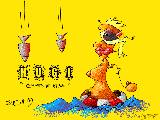
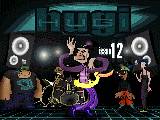
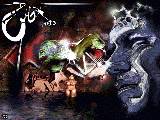



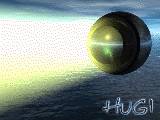
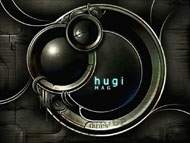

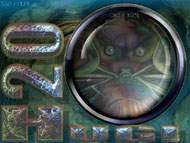
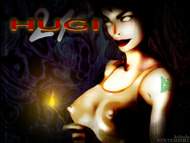


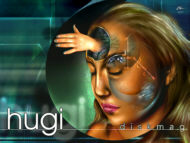

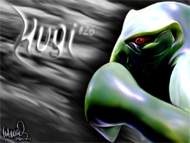
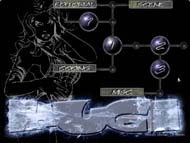
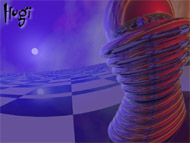


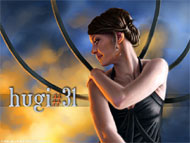



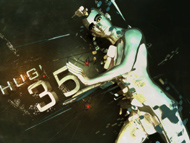

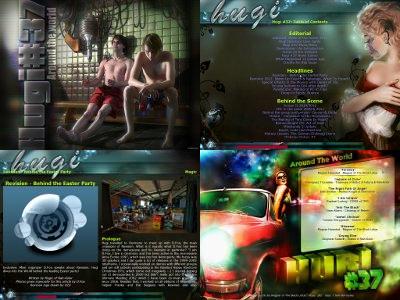
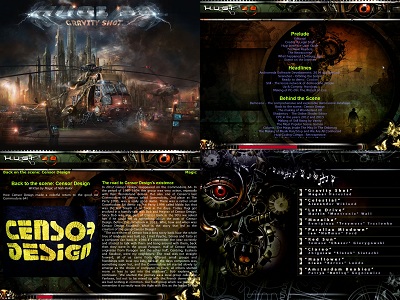
Introduction
Writing has been a great hobby of mine ever since I started adding texts to my comics at the age of 4. At elementary school I already published my first little magazine. For me, magazines have never only been means of communications, but pieces of art. The articles should not only inform and entertain, but they should also be in a good language. And although content is definitely the most important component of a magazine, the layout matters as well.
That's why I, at the age of 12, was so fascinated when I got my first diskmag. It was sent to me by a pen-pal of mine; I had got into contact with him because both of us were writing for the same paper computer magazine. (It was the only computer magazine in German language that entirely consisted of articles submitted by its readers; its name was PC-Heimwerker. God bless it. Unfortunately, it didn't sell well and thus made it only to just a few issues. That's why I was so happy that I discovered diskmags as a substitute.)
Diskmags are magazines that were originally spread via computer disks; these days, they're primarily distributed via the Internet. What distinguishes them from paper magazines is that they're read on screen. In contrast to on-line magazines, they need not be read while a connection to the Internet is established, but only need to be downloaded once and can then be read offline.
Diskmags do not only consist of texts and illustrations; on the contrary, they are complete, interactive computer programs. Each diskmag comes along with its own unique multi-media user interface, featuring background graphics and music, various ways of control, and original ideas such as animated intros, on-the-fly changes to the layout, built-in games and hidden parts.
What may sound playful and impractical to more mature people was a great attraction to a boy in his teens who was still more interested in creating his own worlds instead of trying to understand the one he was actually growing into. It was people only a couple of years older than him who were publishing diskmags. Diskmags were the primary form of publication among the computerized youth. These people belonged to the first generation that had grown up with home computers. As their parents and teachers knew less about the new technology than they themselves did, they had to teach the handling and programming of computers to themselves. Diskmags were the platform this self-organized youth used to exchange knowledge.
There were diskmags of various classes of quality and size, ranging from such containing only a few articles up to huge ones with up to 2 Mbytes of text data (that's about 700 printed pages in DIN-A4 format). There were national magazines published in languages such as German, French, Norwegian, Swedish, Finnish, Hungarian, Polish and Russian, as well as international ones published in English. Every magazine had a different style and focus. Some were more about technical issues, while others focused on entertainment.
What's important is that most of the diskmags which have made to more than just a couple of issues are rooted in particular communities. Among the masses of computer-enthusiastic teenagers there are several groups of people who consider themselves art-producing communities. One of the largest of these communities is the "demo scene".
The Demo Scene
The demo scene actually is an offspring of the crackers scene of the 1980s. Crackers were the bad guys who removed the copy protections from computer games so that kids could freely spread them on their school-yards and far fewer people had to buy the original games at stores. At some stage crackers began to add short animations accompanied by music to the cracked games, the so-called intros. From then it didn't take long until some people started creating stand-alone intros that were spread independently of cracked games. This was the beginning of the demo scene.
Nowadays the demo and crackers scenes are separated. Whilst crackers act against the law, the activities of the demo scene are of legal nature. It has developed to a large community that produces various types of art. The most important among these is the demo, short for demonstration. A demo is a computer program supposed to demonstrate its creators' programming and artistic skills. Demos are usually non-interactive, movie-like shows of graphics effects and 3D fly-throughs, accompanied by a soundtrack and poetry, with a duration of 5 to 30 minutes. They are created by teams of graphicians, musicians and programmers (also called "coders"). Another type of art which is similar to a demo is the intro. These days this term is used for demos with a size limit of 64 or even just 4 kilobytes. This type of art requires excellent programming skills and a lot of patience, since it takes extraordinary ideas and much time to find a way how to get the program code and data small enough.
Demo sceners regularly meet at demo parties, events with a duration of 2 to 4 days at which up to 2000 artists gather in order to show each other their new productions, exchange news and knowledge, and have fun together. The climax of every demo party is the competitions ("compos") at which new demos, intros as well as stand-alone graphics and tracks are presented to the audience, and the audience can vote for their favourites. At the end of a party, a prize ceremony is held for the winners; the prizes mainly comprise computer hardware and software.
It is the demo scene in which the modern type of diskmag, with its lavish multi-media user interface, had its roots. In the pre-Internet era, diskmags such as Imphobia, RAW and Generation served as means of communication during the time in between the parties. Demo scene magazines primarily focused on social aspects; they contained reports about the latest parties, reviews of recent productions, news about the individual demo-making teams, announcements of upcoming projects, interviews with artists, and they also served as a platform for discussions about community-related topics. But they also published tutorials on demo programming and design, short stories and poetry, as well as thoughts about matters that weren't directly related to the demo scene. That is why they also gained popularity outside the scene. For many people diskmags were the introduction to the demo scene that eventually made them become active sceners themselves.
How I got involved
It was a matter of co-incidence that I got into making a diskmag myself. Back in 1996, there were several active diskmags in the German-speaking countries. They weren't demo scene-related at all; on the contrary, they focused on subjects of more general interest such as games, programming, school and politics. I had been writing for a couple of these magazines for a while when I received a letter by a German swapper called Kaktus who said that he was interested in starting a new diskmag and still in need of a user interface. With the little programming skills I had in those days, I created a simple interface and sent it to him. How surprised was I when I received the answer that the interface had not only been accepted, but that I had also been made second main editor!
The first issue of Hugi, which back then officially had an even sillier name, Hugendubelexpress (it hadn't been my idea), was released in May of 1996. It might have been what demo sceners would call a "lame" magazine: bad graphics, soundtrack taken from free music collections, and quite a lot of articles in the German language about more or less uninteresting topics (primarily computer games and school adventures). But the magazine had its audience: mostly 13- to 16-year-old high-school students from Germany, Austria and Switzerland with interest in computers in general, and some of them also having made their first steps into computer programming.
My philosophy was to keep the magazine open-minded towards all topics. It should serve as a platform for its readers where they could write about whatever they were interested in. By means of feed-back and reply-articles, it would soon turn out what the main interests of our readers were; in this way, the contents of the magazine would be self-regulated.
Hugi developed, gained new readers and authors, the visual design improved, the interface was re-programmed from scratch, the style of the articles became slightly less childish, the amount of valuable content, such as programming tutorials, increased. But it wasn't before the 10th issue that the magazine got shapes.
In late 1997, many of the German diskmags had ceased to issue, mostly because their editors had started studying at university and now had less time for and (what probably mattered more) interest in editing a magazine. As a matter of fact, only two diskmags continued to be released on a regular basis: Hugi and Cream. The latter came out far less often than Hugi, but due to its superior design and large amount of articles it was the leading magazine and a role-model for all of our staff. I had great respect for its main editor, who was using the nickname Coctail; we had been in contact since I ventured into diskmag-making, and he had had a great influence on my way of thinking about diskmags. Cream had a similar problem as Hugi: it contained loads of articles on a great variety of topics, but the quality was quite variable since the authors were heterogenous in level of education and interests, and a clear concept was missing. Coctail's idea now was to make Cream a design-magazine focusing on demo scene contents. It would be the first demo scene magazine in German language.
As the demo scene was popular among our readers as well and I had been dreaming of publishing an Imphobia-style magazine, I also considered to make Hugi develop into this direction. However, my plans were yet slightly more radical than Coctail's: I wanted to make Hugi an international magazine, published in the English language. By a fortunate co-incidence, the other main editor of Hugi quit the staff, which gave me full control over the magazine.
A Story of Success
Hugi 11, published in June 1998, featured both an English and a German part, the English part being the dominating one. It was thanks to massive advertising and time-consuming on-line presence in demo scene channels on Internet Relay Chat (IRC) that I succeeded in promoting Hugi in the demo scene within rather short time. The fact that although the last issue of the previously leading magazine, Imphobia, had already been released a year ago, Imphobia had not officially been declared "dead" yet, had left a vacuum which I could easily take advantage of. Soon Hugi became the most popular active diskmag among demo sceners, and many people started supporting it with articles and design elements voluntarily.
In those days, Hugi used to be a huge magazine indeed. From issues 11 to 20, no issue had less than 800 kbytes of articles - that is, in each issue the raw text files (without images and without formattings) occupied more than 800 kbytes of hard-disk space. Assuming an average of 3 kbytes per page (DIN-A4 standard), this means that each of these issues would be at least 250 pages printed. The average text-amount per issue of this period was about 1300 kbytes, that is almost 1.3 Mbytes. The largest issue of all was Hugi 16, released in the summer holidays of 1999; three months of working had resulted in a massive 2.1 Mbytes or 700 pages.
Most of the texts focused on the demo-scene. We initially had a lot of articles on scene philosophy and history before the focus switched to reports about recent events and current trends. Interviews, party reports, demogroups in focus, making-of stories, and fictional short stories involving people from the scene then dominated the magazine. In addition, we also had a large programming corner with very sophisticated articles on elaborate topics such as 3D programming as well as such that focused on rather simple issues pertinent to beginners. Some issues of Hugi had sections on the creation of computer graphics, computer music and technology in general. One issue even had an "adult corner"! (Well, we weren't adults back then.) Finally, all issues contained short stories and poems as well as articles on topics of more general interest such as philosophy, politics and science.
My personal view is that from November 1998 to April 2000, the contents of Hugi reflected the activities in the international PC demo scene very well. In this period, issues 13 to 19 were released. The driving force when creating Hugi in those days was my belief that there ought to be a magazine that covered all events in the demo scene that were of international importance. This task had been fulfilled well by Imphobia until it stopped releasing in 1996; now fortune had decided that Hugi would be its successor.
With time, however, good on-line resources for the international demo scene emerged. One of the best was Orange Juice. It was the most popular news-spreading site. News was easily accessible, and it is archived for a long time. I came to the conclusion that it was no longer necessary to try to keep track of the history of the scene in such an obsessive way as I had done before. Now the focus of the Hugi Magazine switched to interesting and entertaining reports and useful tutorials, and the sections on general topics such as literature and lifestyle grew larger again.
The German part remained in Hugi until issue 17. Afterwards it became a separate magazine called Hugi.GER. But by the time Hugi.GER was released, many of the old readers had already lost interest in the magazine. Thus it did not come as a surprise that Hugi.GER was stopped after three issues.
Since issue 16, Hugi has also been released in the Russian language. The original idea came from a Russian scener who volunteered to translate the whole issue. Since those days, most of the newly released English-language issues were also translated into Russian by a constantly changing group of freelancers.
The End?
After starting to study at university, I no longer had as much time as before I could invest in the Hugi Magazine, but I still saw to it that a new issue with decent contents got released once a while.
Adok/Hugi
Other Magazines about Hugi
Hugi 14 par Hugi Crew
(1999, in "PC Team", French)
Artikel aus dem Untergrund
(1999, in "PC Magazin", German)
Diskmags - das Sprachrohr der Szene
(1999, at www.hackerland.de, German)
Hugi Diskmag 17
(2000, in "PC Team", French)
Hugi Diskmag 18
(2000, in "PC Team", French)
Disketten-Kunst
(2000, in "JavaJim", German)
Diskmagit Haastavat Lukijan
(2001, in a Finnish computer magazine)
Diskmags - das Medium der Demo-Szene
(2002, at www.digitalcraft.org, German)
Bildschirm Maximieren: Digitale Online-Mags im Breitwand-Format
(2004, at www.phlow.net, German)
Math Games: 64K or Less - The Demoscene
(2004, in "MAA Online - The Online Home of the Mathematical Association of America)
Hugi Archive from "the (Swiss) scene server"
Hugi Size Coding Competition: Report by a participant, krick